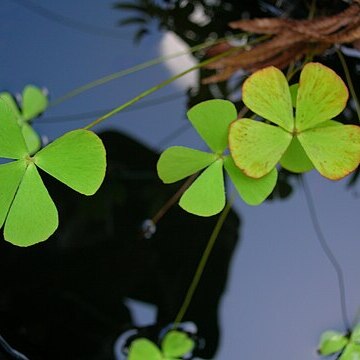Lvs long-petiolate, the blade mostly floating or emergent, with 4 approximate lfls (2 juxtaposed pairs) regularly spreading from the petiole-tip and suggesting a 4-lvd clover; lfls dichotomously and reticulately veined, and with an intramarginal connecting vein; sporocarp longitudinally ± bilocular and with many transverse partitions, finally dehiscent by 2 valves, somewhat compressed, ± ovate or elliptic, in many spp. (including ours) attached laterally to the distal part of the peduncle, which forms a raphe that may project as an “inferior” tooth; a “superior” tooth often also present on the upper side of the sporocarp a little above the base; sori several or many, each with central megasporangia and lateral microsporangia on an elongate receptacle. 45, cosmop.
Fronds in deeper water with stipes lax and slender and pinnae floating upon water surface; fronds in shallow water or on land with erect stipes and pinnae oriented in various positions by action of basal pulvini; pinnae 4, obtriangular to fan-shaped, clustered at tip of stipe. Veins of pinnae forking dichotomously, anastomosing to form elongate areoles. Sporocarps 1 to many per frond, quadrate to elliptic in lateral view, leathery to woody when mature. Sori oblong, with few megasporangia and numerous microsporangia in each sorus. Megaspore ovoid-globose with a terminal papilla; spore wall thin, indistinctly reticulate. Microspores globose; spore wall thin, indistinctly sculptured. x = 20.
Rhizome long-creeping, bearing nodal roots and peltate apical scales. Sterile fronds borne at the nodes, solitary or clustered, erect on plants growing in mud, floating when growing in water, consisting of a slender stipe and 2 pairs of spreading glabrous or scaly terminal leaflets resembling a 4-leaf clover (sometimes reduced to 1 erect leaflet in juvenile growth); outer margin entire or crenate; venation anastomosing, forming narrow areoles without included veinlets. Sporocarps stalked, solitary or clustered; conceptacles spherical or laterally flattened, smooth or ribbed, glabrous or scaly, often toothed near the junction with the stalk.
Mostly aquatic ferns. Rhizomes long-creeping, rooting at nodes. Lvs arising at nodes, with long stalks terminating in 4 obtriangular or flabellate segments, glabrous or hairy; veins anastomosing. Sori containing both micro-and megasporangia, protected by indusia, and contained within hard sporocarps attached near the base of the lvs. Spores trilete.

